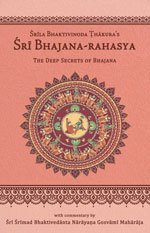Bhajana-Rahasya
by Srila Bhaktivinoda Thakura Mahasaya | 2010 | 123,965 words
The Bhajana-rahasya Text 20, English translation, including commentary (vritti). The Bhajana-rahasya is a compilation of verses describing the mercy of the eight pairs of names (Yugala-nama) of the Maha-mantra. This is text 20 belonging to the chapter “Dvitiya-yama-sadhana (Pratah-kaliya-bhajana)” representing the first six dandas of the morning: approximately 6.00 a.m.–8.30 a.m.
Text 20
It is forbidden to judge a transcendental Vaiṣṇava from a material viewpoint. Śrī Upadeśāmṛta (6) states:
दृष्टैः स्वभाव-जनितैर् वपुषश् च दोषैर् न प्राकृतत्वम् इह भक्त-जनस्य पश्येत्
गङ्गाम्भसां न खलु बुद्बुद-फेन-पङ्कैर् ब्रह्म-द्रवत्वम् अपगच्छति नीर-धर्मैःdṛṣṭaiḥ svabhāva-janitair vapuṣaś ca doṣair na prākṛtatvam iha bhakta-janasya paśyet
gaṅgāmbhasāṃ na khalu budbuda-phena-paṅkair brahma-dravatvam apagacchati nīra-dharmaiḥDevotees who are in this material world should not be considered material; that is, one should not consider them ordinary conditioned souls. Imperfections seen in their natures, such as birth in a low caste, harshness or letharg y, and the imperfections seen in their bodies, such as ugly features, disease or deformities, are precisely like the appearance of bubbles, foam and mud in the Gaṅgā. Despite such apparent pollution of her water, the Gaṅgā retains her nature as liquefied transcendence. Similarly, one should not attribute material defects to self-realised Vaiṣṇavas.
स्वभाव-जनित आर वपु-दोषे क्षणे
अनादर नाहि कर शुद्ध-भक्त-जनेsvabhāva-janita āra vapu-doṣe kṣaṇe
anādara nāhi kara śuddha-bhakta-janeपङ्कादि जुलीय दोषे कभु गङ्गा-जले
चिन्मयत्व लोप नहे, सर्व-शास्त्रे बलेpaṅkādi julīya doṣe kabhu gaṅgā-jale
cinmayatva lopa nahe, sarva-śāstre baleअप्राकृत भक्त-जन पाप नाहि करे
अवशिष्ट पाप याय किछु दिन परेaprākṛta bhakta-jana pāpa nāhi kare
avaśiṣṭa pāpa yāya kichu dina pare
Commentary: Bhajana-rahasya-vṛtti:
The instruction of this Text is that it is improper to consider pure devotees to be material or to see material defects in them. They may have defects in their bodies or natures, but it is impossible for pure devotees to fall into bad association or commit nāma-aparādha. The water of the Gaṅgā is considered to be pure, despite the appearance of bubbles, foam, mud, etc., for its nature as liquefied transcendence is never lost. Similarly, self-realised Vaiṣṇavas are not contaminated by the birth of the material body nor by its deterioration. Therefore, one who is intent on performing bhajana should never disrespect a pure Vaiṣṇava, even if these defects are apparent in him. The remaining imperfections of a Vaiṣṇava are quickly removed, and if someone even looks for them he becomes an offender.
